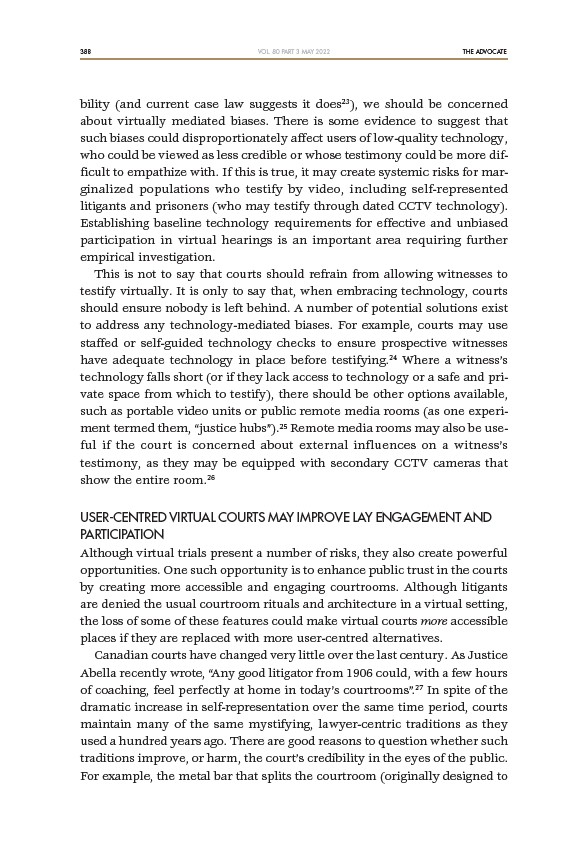
388 THE ADVOCATE
VOL. 80 PART 3 MAY 2022
bility (and current case law suggests it does23), we should be concerned
about virtually mediated biases. There is some evidence to suggest that
such biases could disproportionately affect users of low-quality technology,
who could be viewed as less credible or whose testimony could be more difficult
to empathize with. If this is true, it may create systemic risks for marginalized
populations who testify by video, including self-represented
litigants and prisoners (who may testify through dated CCTV technology).
Establishing baseline technology requirements for effective and unbiased
participation in virtual hearings is an important area requiring further
empirical investigation.
This is not to say that courts should refrain from allowing witnesses to
testify virtually. It is only to say that, when embracing technology, courts
should ensure nobody is left behind. A number of potential solutions exist
to address any technology-mediated biases. For example, courts may use
staffed or self-guided technology checks to ensure prospective witnesses
have adequate technology in place before testifying.24 Where a witness’s
technology falls short (or if they lack access to technology or a safe and private
space from which to testify), there should be other options available,
such as portable video units or public remote media rooms (as one experiment
termed them, “justice hubs”).25 Remote media rooms may also be useful
if the court is concerned about external influences on a witness’s
testimony, as they may be equipped with secondary CCTV cameras that
show the entire room.26
USER-CENTRED VIRTUAL COURTS MAY IMPROVE LAY ENGAGEMENT AND
PARTICIPATION
Although virtual trials present a number of risks, they also create powerful
opportunities. One such opportunity is to enhance public trust in the courts
by creating more accessible and engaging courtrooms. Although litigants
are denied the usual courtroom rituals and architecture in a virtual setting,
the loss of some of these features could make virtual courts more accessible
places if they are replaced with more user-centred alternatives.
Canadian courts have changed very little over the last century. As Justice
Abella recently wrote, “Any good litigator from 1906 could, with a few hours
of coaching, feel perfectly at home in today’s courtrooms”.27 In spite of the
dramatic increase in self-representation over the same time period, courts
maintain many of the same mystifying, lawyer-centric traditions as they
used a hundred years ago. There are good reasons to question whether such
traditions improve, or harm, the court’s credibility in the eyes of the public.
For example, the metal bar that splits the courtroom (originally designed to